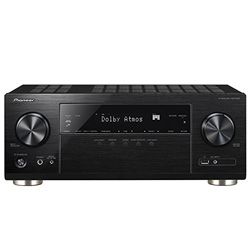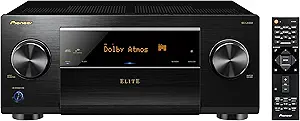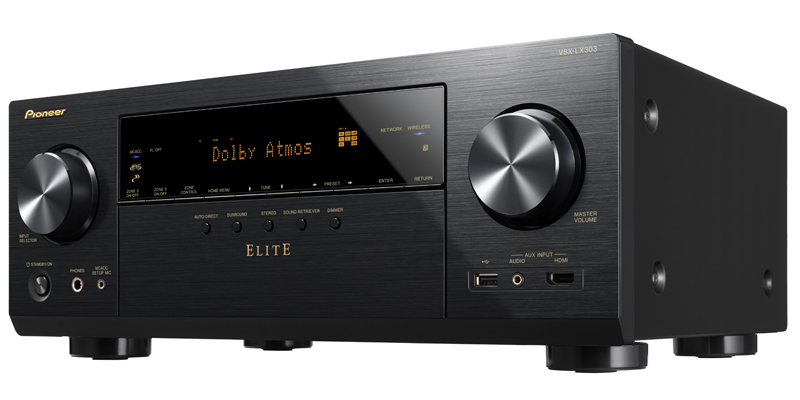The Pioneer AV receiver and the Yamaha AV receiver are both high-quality pieces of audio equipment that offer a range of features to enhance your home audio experience. The Pioneer AV receiver is known for its Direct Energy Design and Clean Ground Construction, which offer a clean and clear audio performance. It also has the latest technologies such as Dolby Atmos and DTS:X playback, and it supports Ultra HD pass-through with HDCP 2.2, HDR10, HLG, and Dolby Vision. On the other hand, the Yamaha AV receiver is praised for its MusicCast Surround technology that allows for a wireless home theater setup. It also supports Dolby Atmos and DTS:X, and it has a built-in Wi-Fi, Bluetooth, AirPlay 2, and Spotify Connect. In terms of brand comparison, Pioneer has a reputation for producing reliable and durable AV receivers, but they are often more expensive than their counterparts. Yamaha, on the other hand, is known for its high-quality sound and innovative features, but some users have reported issues with its user interface and setup process. Both brands offer a range of models to suit different budgets and needs, and they are both highly regarded in the audio equipment industry. However, the choice between the two will largely depend on your specific requirements and preferences.
Key Features Comparison
Product Selection
Pioneer and Yamaha both offer a diverse range of AV receivers, catering to different needs and budgets. Pioneer's product selection includes the VSX series and the elite SC series, which are known for their high-quality sound and video performance. The latest Pioneer AV receivers come with advanced technologies such as Dolby Atmos, DTS:X, and MCACC auto room tuning, which enhance the audio experience. However, some users have noted that Pioneer's user interface can be complex and challenging to navigate. On the other hand, Yamaha's AV receivers, which include the RX-V and Aventage series, are praised for their robust build quality and exceptional sound clarity. Yamaha's latest models are equipped with technologies like MusicCast multi-room technology, Dolby Atmos, and DTS:X, offering a similar level of audio enhancement as Pioneer. Yamaha also offers a more user-friendly interface and is often lauded for its YPAO sound optimization system, which automatically adjusts audio settings to suit your room's acoustics. However, some users find Yamaha's receivers to be on the pricier side compared to other brands. In comparison to Pioneer, Yamaha's product selection is slightly more extensive, offering a broader range of options for different user needs and budgets.
Design/Look
The design of the Pioneer AV receiver is sleek and modern, with a black brushed metal finish that is both attractive and durable. The front panel is minimalist, with a large volume knob and a small selection of buttons for input selection and tuning. The display is clear and easy to read, but not overly bright, which can be a benefit in a darkened home theater setting. The rear panel is well laid out, with clear labeling for all inputs and outputs. The Pioneer AV receiver also includes the latest technologies such as Dolby Atmos, DTS:X, and HDMI 2.1 support, which are neatly integrated into the design. On the other hand, the Yamaha AV receiver also sports a modern design, but with a slightly more robust and industrial feel. It has a larger front panel with more buttons and dials, which may appeal to users who prefer a more hands-on approach to their audio setup. The display is large and bright, with a wealth of information available at a glance. The rear panel is equally well organized, with a comprehensive range of inputs and outputs. Yamaha AV receiver also incorporates the latest technologies like MusicCast multi-room audio and support for Dolby Atmos and DTS:X. However, it's worth noting that while both brands have their strengths, the choice between Pioneer and Yamaha may ultimately come down to personal preference in design aesthetics.
Affordability
Most affordable brands
When it comes to the price aspect of audio equipment, both Pioneer and Yamaha AV receivers have their own merits and demerits. Pioneer AV receivers, known for their advanced technologies like MCACC auto room tuning and Synchronized Sound with Phase Control, tend to be priced reasonably, making them a popular choice among budget-conscious consumers. However, the cost can rise significantly when opting for their high-end models, which incorporate the latest technologies like Dolby Atmos and DTS:X playback. On the other hand, Yamaha AV receivers, while also offering high-end features like MusicCast Surround technology and Dolby Atmos, tend to be on the higher end of the price spectrum. This is largely due to their reputation for robust build quality, exceptional sound performance, and the inclusion of proprietary technologies like YPAO sound optimization. Compared to other brands, both Pioneer and Yamaha offer competitive pricing, but the final decision often comes down to the specific features and audio quality that a consumer values. It's worth noting that while Yamaha's initial cost might be higher, the longevity and performance of their receivers could potentially offer better value for money in the long run.
Quality/Durability
Pioneer AV Receivers and Yamaha AV Receivers are two popular brands in the audio and video receiver market, both known for their quality and durability. Pioneer AV Receivers are equipped with the latest technologies such as Direct Energy HD Amplifier, MCACC Pro Auto Room Tuning, and support for Dolby Atmos and DTS:X. These features ensure high-quality audio and video output, and the receivers are built to last with robust construction. However, some users have reported issues with the software updates and customer service of Pioneer. On the other hand, Yamaha AV Receivers, known for their MusicCast Surround technology and support for Dolby Atmos and DTS:X, offer a high level of audio and video quality. Yamaha receivers are also built with durability in mind, featuring a rigid chassis and high-quality internal components. They are generally praised for their reliability and longevity. One downside of Yamaha receivers is that they can be more expensive than other brands, but many users find the extra cost to be justified by the superior performance and durability. Compared to Pioneer, Yamaha has a better reputation for customer service and regular software updates.
Reputation
Pioneer and Yamaha are both highly reputed brands in the audio equipment industry, each with their unique strengths. The Pioneer AV receiver is well-known for its advanced technologies and high-quality sound. Pioneer's latest AV receivers, such as the VSX-LX504 and VSX-LX304, are equipped with Direct Energy amplification, Dolby Atmos, DTS:X, and support for IMAX Enhanced content, ensuring an immersive audio experience. However, some users have reported that Pioneer's user interface is not as intuitive as it could be, and the brand's customer service has received mixed reviews. On the other hand, Yamaha AV receivers are praised for their exceptional sound quality, durability, and ease of use. The brand's latest models, like the RX-V6A and RX-V4A, feature technologies such as 8K HDMI support, Dolby Atmos with Height Virtualization, and Yamaha's proprietary MusicCast system for multi-room audio. Yamaha's user interface is generally considered user-friendly, and the brand has a strong reputation for customer service. However, some users have noted that Yamaha receivers may not offer as many features as some other brands in the same price range. Both brands are highly competitive in the market, offering different strengths depending on the specific needs and preferences of the user.
Conclusion
When it comes to audio equipment, both Pioneer and Yamaha AV receivers have their unique strengths and weaknesses. Pioneer AV receivers are known for their high-quality sound, advanced MCACC auto-calibration system, and support for latest technologies such as Dolby Atmos, DTS:X, and 4K Ultra HD pass-through. They also offer a wide range of connectivity options, including HDMI, USB, and Bluetooth. However, they can be somewhat complex to set up and use, especially for beginners. On the other hand, Yamaha AV receivers are praised for their solid build quality, easy-to-use interface, and innovative YPAO sound optimization system. They also support latest technologies like Dolby Atmos, DTS:X, and 4K Ultra HD pass-through, and offer a variety of connectivity options. However, some users have reported that the sound quality of Yamaha receivers is not as warm or rich as that of Pioneer receivers. Comparatively, Yamaha AV receivers are more user-friendly and easier to set up, which might make them a better choice for those who are new to home theater systems. Both brands are well-regarded in the audio equipment industry, and the choice between them often comes down to personal preference.




















